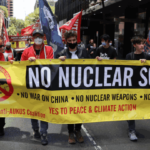Welcome to the Australian War Economy, Where Offense Is the New Defence

After last month’s AUKUS announcement, it’s been clear that the nation’s global military stance is shifting dramatically.
In its acquisition of nuclear-powered submarines, Australia, a middle power, is no longer solely concerned with its defence, but rather it’s now becoming a nation on the offensive foot.
Monday’s release of the Albanese government-commissioned Defence Strategic Review 2023, further confirms that our domestic economy will increasingly be reliant upon war, with a planned bolstering of the local military industrial complex, along with a “significant financial commitment”.
Albanese explained at a 24 April presser, that the National Security Committee – a body made up of the PM and a handful of key ministers that decides whether to enter into war – has long been deliberating over how much money it can shift towards the “defence industry” prior to the budget.
“The defence posture that we have had for the last few decades has served our nation well. But in the circumstances that we now face, that defence posture is no longer fit for purpose,” said defence minister Richard Marles, in outlining the “recasting of the mission of the Australian Defence Force”.
And in combining the DSR response with our ever-increasing interoperability with US forces and the build-up to war with China, our nation is fast becoming a frontline base for Washington in that conflict, while the economy is being transformed into one that relies on perpetual US-led wars.
Defensive to offensive
“This review and the government’s response to it does provide for a reshaping of the Australian Army, but in a way which gives it a much greater strike capability and a much longer-range strike capability, but also a much greater ability to operate in a littoral environment,” said Marles.
The minister explained that the largest defence reform in 35 years consists of five elements: defend the nation and region, deter foreign attack through denial, protect economic connections abroad, be part of a collective Indo Pacific securitisation and maintain the global rules-based order.
“Now, most of those objectives, as part of the new mission of the Australian Defence Force, are well beyond our shores,” the hawkish Marles added. “And so, we need to have a defence force which has the capacity to engage in impactful projection through the full spectrum of proportionate response.”
The government has agreed to the overwhelming majority of the DSR’s 62 recommendations, whilst agreeing in-principle with the remaining handful. And in responding last Monday, federal Labor has “identified six priority areas for immediate action”.
These urgent matters include acquiring nuclear-powered subs, enhancing ability to strike at longer-range, improving operational ability in northern bases, growing and retaining a highly-skilled military, lifting capacity to incorporate disruptive new technologies and deepening Indo Pacific relations.
Pissing it up against the fortress
“Defence spending will need to grow,” Marles said, without adding that this financial increase will come at the expense of social sectors, and in turn, will impact those who most rely on publicly-funded services, working people, which is a section of society Labor had once sought to represent.
“It is absolutely our expectation that defence spending over the medium term, over the decade, will grow above the existing trajectory of growth that we inherited from the former government,” the minister added, in suggesting that the defence spend is inevitable and the Coalition kept it from us.
The cost of the forward estimates of the “comprehensive plan” is already covered in the upcoming budget, the PM and defence minister assured. And this comprises of a tidy $19 billion spend, with $7.8 billion having been sourced via the reprioritisation of unspecified programs.
However, just last month, Albanese stood on a podium beside US president Joe Biden and explained that the AUKUS sub agreement will involve up to $368 billion to 2055, whilst the last government locked us in to a $270 billion spend on US military equipment spread out over the ten years to 2030.
In line with this increasing need for military spending, as well as the renewed focus on bolstering the ADF so that it has the capacity to go on the attack more readily, the government has agreed with the DSR suggestion to “move away from intermittent white papers to a biennial National Defence Strategy”.
And just in case voters aren’t convinced with the spike in military spending, minister for the defence industry Pat Conroy piped in with, “We are being honest and transparent with the Australian people in saying that we do need to reprioritise, and that includes changing some projects.”
Our very own military-industrial complex
Included in the second priority area, which entails the ADF developing its “ability to precisely strike targets at longer-range”, is a further commitment to see the nation manufacturing these munitions, while the fifth prong has Australia rapidly incorporating “new technologies into ADF capability”.
And whilst becoming less reliant on the US for our nation’s military capabilities sounds about right, investing in an ever-expanding local military industry will mean that to keep its profits rolling in, eventually those weapons have to be used on human targets in order to grow demand.
Indeed, a much larger weapons industry will make it increasingly profitable to enter into more foreign battles, and, on top of that, selling these lethal products to other powers for ultimate use upon not only on enemy soldiers but civilian populations, will ensure our growing standard of living.
“We need a sovereign defence industrial base in this country if we are truly to be independent and sovereign and have supply chain resilience,” said Conroy, adding that there is now a commitment to manufacturing guided weapons and explosive ordinance, along with continuous shipbuilding.
But for those who consider handing over cash to foreign weapons industries is of benefit to our nation, there’s no need to worry, as Conroy assures that “the government has accepted significant reforms to defence procurement to increase the speed of our acquisitions”.
The coming war with China
A stark aspect of the announcement was the dearth in any mention of China. In fact, it was left to a reporter to ask about “the possible invasion of Taiwan”, to which the PM said his party calls “for a peaceful resolution through dialogue”, mimicking foreign minister Penny Wong’s recent assertions.
But the DSR report is much more forthright on China, stating that “our alliance partner, the United States, is no longer the unipolar leader of the Indo Pacific”, with a “return of major power strategic competition, the intensity of which should be seen as the defining feature of our region and time”.
According to the report, the US alliance will remain central to “Australia’s security and strategy”, with a focus on the US rotational force posture initiatives, which see a permanent local US presence that includes troops, air force capabilities and soon a joint US-UK nuclear-powered submarine force.
So, whilst the Scott Morrison-Peter Dutton tag team conducted a superb priming of the public to the false claim that we must attack China before it turns on us, the Albanese-Marles duo are readying the ADF for that war and ensuring that the weapons industry is a major breadwinner going forward.







